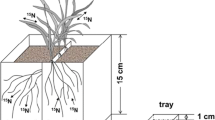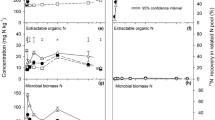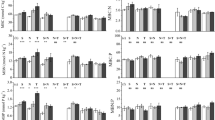Abstract
Background and aims
Plants can directly affect nitrogen (N) transformation processes at the micro-ecological scale when soil comes into contact with roots. Due to the methodological limitations in measuring direct N2 losses in plant-soil systems, however, the effect of rhizosphere processes on N2O production and reduction to N2 has rarely been quantified.
Methods
For the first time, we developed a robotic continuous flow plant-soil incubation system (using a He+O2 + CO2) combined with N2O 15N site preference approach to examine the effect of plant root activity (barley – Hordeum vulgare L.) on: i) soil-borne N2O and N2 emissions, ii) the specific contribution of different pathways to N2O fluxes in moist soils (85% water holding capacity) receiving different inorganic N forms.
Results
Our results showed that when a nitrate-based N fertiliser was applied, the presence of plants tripled both N2O and N2 losses during the growth period but did not alter the N2O/(N2O + N2) product ratio. The 15N site preference data indicated that bacterial denitrification was the dominant source contributing to the observed N2O fluxes in both nitrate and ammonium treated soils, whereas the presence of barley increased the contribution of fungal N2O in the nitrate treated soils. During the post-harvest period, N2O and N2 emissions significantly increased in the ammonium-fertilised treatment, being more pronounced in the soil with a senescing root system.
Conclusion
Overall, our study showed a significant interaction between rhizosphere processes and N forms on the magnitude, patterns, and sources of soil borne N2O and N2 emissions in moist agricultural soils.



Similar content being viewed by others
References
Baggs EM, Richter M, Cadisch G, Hartwig UA (2003) Denitrification in grass swards is increased under elevated atmospheric CO2. Soil Biol Biochem 35:729–732. https://doi.org/10.1016/S0038-0717(03)00083-X
Bakken LR (1988) Denitrification under different cultivated plants: effects of soil moisture tension, nitrate concentration, and photosynthetic activity. Biol Fertil Soils 6:271–278. https://doi.org/10.1007/BF00261011
Bingham IJ, Rees RM (2008) Senescence and N release from clover roots following permanent excision of the shoot. Plant Soil 303:229–240. https://doi.org/10.1007/s11104-007-9501-4
Blackmer AM, Bremner JM (1978) Inhibitory effect of nitrate on reduction of N2O to N2 by soil microorganisms. Soil Biol Biochem 10:187–191. https://doi.org/10.1016/0038-0717(78)90095-0
Broeckling CD, Broz AK, Bergelson J, Manter DK, Vivanco JM (2008) Root exudates regulate soil fungal community composition and diversity. Appl Environ Microbiol 74:738–744
Cai Z, Laughlin RJ, Stevens RJ (2001) Nitrous oxide and dinitrogen emissions from soil under different water regimes and straw amendment. Chemosphere 42:113–121
Cardenas LM, Hawkins JMB, Chadwick D, Scholefield D (2003) Biogenic gas emissions from soils measured using a new automated laboratory incubation system. Soil Biol Biochem 35:867–870
Chang C, Janzen HH, Nakonechny EM, Cho CM (1998) Nitrous oxide emission through plants. Soil Sci Soc Am J 62:35–38
Chen X, Boeckx P, Shen S, Van Cleemput O (1999) Emission of N2O from rye grass (Lolium perenne L.). Biol Fertil Soils 28:393–396. https://doi.org/10.1007/s003740050510
Cheneby D, Perrez S, Devroe C et al (2004) Denitrifying bacteria in bulk and maize-rhizospheric soil: diversity and N2O-reducing abilities. Can J Microbiol 50:469–474
Coskun D, Britto DT, Shi W, Kronzucker HJ (2017) Nitrogen transformations in modern agriculture and the role of biological nitrification inhibition. Nature Plants 3:17074
De Graaff M-A, Classen AT, Castro HF, Schadt CW (2010) Labile soil carbon inputs mediate the soil microbial community composition and plant residue decomposition rates. New Phytol 188:1055–1064
Decock C, Six J (2013) How reliable is the intramolecular distribution of 15N in N2O to source partition N2O emitted from soil? Soil Biol Biochem 65:114–127. https://doi.org/10.1016/j.soilbio.2013.05.012
Dilkes NB, Jones DL, Farrar J (2004) Temporal dynamics of carbon partitioning and rhizodeposition in wheat. Plant Physiol 134:706–715
Farrar J, Hawes M, Jones D, Lindow S (2003) How roots control the flux of carbon to the rhizosphere. Ecology 84:827–837
Groffman PM, Altabet MA, Böhlke JK, Butterbach-Bahl K, David MB, Firestone MK, Giblin AE, Kana TM, Nielsen LP, Voytek MA (2006) Methods for measuring denitrification: diverse approaches to a difficult problem. Ecol Appl 16:2091–2122
Guyonnet JP, Vautrin F, Meiffren G et al (2017) The effects of plant nutritional strategy on soil microbial denitrification activity through rhizosphere primary metabolites. FEMS Microbiol Ecol 93:fix022
Hayashi K, Tokida T, Kajiura M et al (2015) Cropland soil–plant systems control production and consumption of methane and nitrous oxide and their emissions to the atmosphere. Soil Sci Plant Nutr 61:2–33
Hayden HL, Mele PM, Bougoure DS, Allan CY, Norng S, Piceno YM, Brodie EL, Desantis TZ, Andersen GL, Williams AL, Hovenden MJ (2012) Changes in the microbial community structure of bacteria, archaea and fungi in response to elevated CO2 and warming in an a ustralian native grassland soil. Environ Microbiol 14:3081–3096
Henry S, Texier S, Hallet S, Bru D, Dambreville C, Chèneby D, Bizouard F, Germon JC, Philippot L (2008) Disentangling the rhizosphere effect on nitrate reducers and denitrifiers: insight into the role of root exudates. Environ Microbiol 10:3082–3092
Herman DJ, Johnson KK, Jaeger CH et al (2006) Root influence on nitrogen mineralization and nitrification in Avena barbata rhizosphere soil. Soil Sci Soc Am J 70:1504–1511
ISSS, I. FAO 1998. World reference base for soil resources, 84.
Jones DL, Clode PL, Kilburn MR, Stockdale EA, Murphy DV (2013) Competition between plant and bacterial cells at the microscale regulates the dynamics of nitrogen acquisition in wheat (Triticum aestivum). New Phytol 200:796–807
Klemedtsson L, Berg P, Clarholm M et al (1987) Microbial nitrogen transformations in the root environment of barley. Soil Biol Biochem 19:551–558
Kuzyakov Y, Razavi BS (2019) Rhizosphere size and shape: temporal dynamics and spatial stationarity. Soil Biol Biochem
Kuzyakov Y, Xu X (2013) Competition between roots and microorganisms for nitrogen: mechanisms and ecological relevance. New Phytol 198:656–669
Langarica-Fuentes A, Manrubia M, Giles ME et al (2018) Effect of model root exudate on denitrifier community dynamics and activity at different water-filled pore space levels in a fertilised soil. Soil Biol Biochem 120:70–79
Laughlin RJ, Stevens RJ (2002) Evidence for fungal dominance of denitrification and codenitrification in a grassland soil. Soil Sci Soc Am J 66:1540–1548
LeBauer DS, Treseder KK (2008) Nitrogen limitation of net primary productivity in terrestrial ecosystems is globally distributed. Ecology 89:371–379. https://doi.org/10.1890/06-2057.1
Lebender U, Senbayram M, Lammel J, Kuhlmann H (2014) Impact of mineral N fertilizer application rates on N2O emissions from arable soils under winter wheat. Nutr Cycl Agroecosyst 100:111–120
Lenhart K, Behrendt T, Greiner S, Steinkamp J, Well R, Giesemann A, Keppler F (2019) Nitrous oxide effluxes from plants as a potentially important source to the atmosphere. New Phytol 221:1398–1408
Lewicka-Szczebak D, Well R, Köster JR et al (2014) Experimental determinations of isotopic fractionation factors associated with N2O production and reduction during denitrification in soils. Geochim Cosmochim Acta 134:55–73
Marella VS, Roberts P, Hill PW, Jones DL (2017) Different ways in which CO2 can be released during the turnover of roots in soil. Biol Fertil Soils 53:369–374
Nadeem S, Dörsch P, Bakken LR (2013) Autoxidation and acetylene-accelerated oxidation of NO in a 2-phase system: implications for the expression of denitrification in ex situ experiments. Soil Biol Biochem 57:606–614
Paterson E, Thornton B, Midwood AJ, Sim A (2005) Defoliation alters the relative contributions of recent and non-recent assimilate to root exudation from Festuca rubra. Plant Cell Environ 28:1525–1533
Philippot L (2002) Denitrifying genes in bacterial and Archaeal genomes. Biochim Biophys Acta (BBA) - Gene Struct Exp 1577:355–376. https://doi.org/10.1016/S0167-4781(02)00420-7
Qin S, Zhang Z, Yu L et al (2017) Enhancement of subsoil denitrification using an electrode as an electron donor. Soil Biol Biochem 115:511–515. https://doi.org/10.1016/j.soilbio.2017.09.020
Ravishankara AR, Daniel JS, Portmann RW (2009) Nitrous oxide (N2O): the dominant ozone-depleting substance emitted in the 21st century. Science 326:123–125
Saglio PH, Pradet A (1980) Soluble sugars, respiration, and energy charge during aging of excised maize root tips. Plant Physiol 66:516–519
Senbayram M, Chen R, Mühling KH, Dittert K (2009) Contribution of nitrification and denitrification to nitrous oxide emissions from soils after application of biogas waste and other fertilizers. Rapid Commun Mass Spectrom 23:2489–2498. https://doi.org/10.1002/rcm.4067
Senbayram M, Chen R, Budai A et al (2012) N2O emission and the N2O/(N2O+N2) product ratio of denitrification as controlled by available carbon substrates and nitrate concentrations. Agric Ecosyst Environ 147:4–12. https://doi.org/10.1016/j.agee.2011.06.022
Senbayram M, Well R, Bol R et al (2018) Interaction of straw amendment and soil NO3− content controls fungal denitrification and denitrification product stoichiometry in a sandy soil. Soil Biol Biochem 126:204–212
Shi S, Richardson AE, O’Callaghan M et al (2011) Effects of selected root exudate components on soil bacterial communities. FEMS Microbiol Ecol 77:600–610
Shoun H, Fushinobu S, Jiang L et al (2012) Fungal denitrification and nitric oxide reductase cytochrome P450nor. Philos Trans R Soc B Biol Sci 367:1186–1194
Smith KA (2010) Nitrous oxide and climate change. Earthscan, London, UK
Smith MS, Tiedje JM (1979) The effect of roots on soil denitrification 1. Soil Sci Soc Am J 43:951–955
Stefanson RC (1972) Soil denitrification in sealed soil-plant systems. Plant Soil 37:113–127
Subbarao GV, Nakahara K, Hurtado MP, Ono H, Moreta DE, Salcedo AF, Yoshihashi AT, Ishikawa T, Ishitani M, Ohnishi-Kameyama M, Yoshida M, Rondon M, Rao IM, Lascano CE, Berry WL, Ito O (2009) Evidence for biological nitrification inhibition in Brachiaria pastures. Proc Natl Acad Sci U S A 106:17302–17307. https://doi.org/10.1073/pnas.0903694106
Subbarao GV, Nakahara K, Ishikawa T et al (2013) Biological nitrification inhibition (BNI) activity in sorghum and its characterization. Plant Soil 366:243–259
Sun L, Lu Y, Yu F, Kronzucker HJ, Shi W (2016) Biological nitrification inhibition by rice root exudates and its relationship with nitrogen-use efficiency. New Phytol 212:646–656
Toyoda S, Yoshida N (1999) Determination of nitrogen isotopomers of nitrous oxide on a modified isotope ratio mass spectrometer. Anal Chem 71:4711–4718
Toyoda S, Yoshida N, Koba K (2017) Isotopocule analysis of biologically produced nitrous oxide in various environments. Mass Spectrom Rev 36:135–160
Vinther FP (1984) Total denitrification and the ratio between N2O and N2 during the growth of spring barley. Plant Soil 76:227. https://doi.org/10.1007/BF02205582
Wang R, Willibald G, Feng Q, Zheng X, Liao T, Brüggemann N, Butterbach-Bahl K (2011) Measurement of N2, N2O, NO, and CO2 emissions from soil with the gas-flow-soil-core technique. Environ Sci Technol 45:6066–6072
Weier KL, Doran JW, Power JF, Walters DT (1993) Denitrification and the dinitrogen/nitrous oxide ratio as affected by soil water, available carbon, and nitrate. Soil Sci Soc Am J 57:66–72
Wu D, Senbayram M, Well R et al (2017) Nitrification inhibitors mitigate N2O emissions more effectively under straw-induced conditions favoring denitrification. Soil Biol Biochem 104:197–207. https://doi.org/10.1016/j.soilbio.2016.10.022
Wu D, Wei Z, Well R et al (2018) Straw amendment with nitrate-N decreased N2O/(N2O+ N2) ratio but increased soil N2O emission: a case study of direct soil-born N2 measurements. Soil Biol Biochem 127:301–304
Zhong L, Bowatte S, Newton PC et al (2018) An increased ratio of fungi to bacteria indicates greater potential for N2O production in a grazed grassland exposed to elevated CO2. Agric Ecosyst Environ 254:111–116
Acknowledgements
This study was funded by the Deutsche Forschungsgemeinschaft through the project “Fluxes and mechanisms of permanent nitrogen removal and N2O production in a heavy nitrogen loaded regions of China” (GZ 1262). This work was also supported by the TÜBITAK (119R042), the National Natural Science Foundation of China (Nos. 41907024), the Scientific Instrument and Equipment Development Project of CAS (YJKYYQ20170058) and UK-China Virtual Joint Centre for Agricultural Nitrogen (CINAg, BB/N013468/1), which is jointly supported by the Newton Fund, via UK BBSRC and NERC, and the Chinese Ministry of Science and Technology. We thank Annete Giesseman, Martina Heuer and Jennifer Ehe for stable isotope analysis, Ute Tambor for Nmin, and Daniel Ziehe for C-N analysis.
Author information
Authors and Affiliations
Corresponding author
Additional information
Responsible Editor: Zucong Cai.
Publisher’s note
Springer Nature remains neutral with regard to jurisdictional claims in published maps and institutional affiliations.
Rights and permissions
About this article
Cite this article
Senbayram, M., Well, R., Shan, J. et al. Rhizosphere processes in nitrate-rich barley soil tripled both N2O and N2 losses due to enhanced bacterial and fungal denitrification. Plant Soil 448, 509–522 (2020). https://doi.org/10.1007/s11104-020-04457-9
Received:
Accepted:
Published:
Issue Date:
DOI: https://doi.org/10.1007/s11104-020-04457-9




